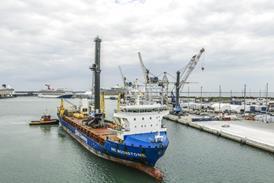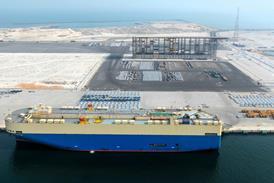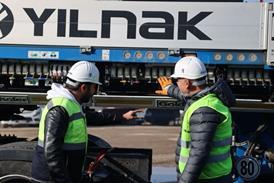July 21 - The formation of 2M is only the conclusion of the latest round of mega-alliance negotiations. Much more lies ahead, says Drewry Maritime Research.
Ocean carriers are clearly not yet done with mega-alliance expansion following China's rejection of P3. Maersk and MSC's subsequent 2M agreement is only the latest. Evergreen and the CKYH alliance are still talking to the US' Federal Maritime Commission (FMC) about extending the scope of their operating agreement between Asia and Europe to include the Ua, and CMA CGM has yet to clarify who its new partners will be.
The Drewry report says that new partnerships are required as no one has yet come up with a better alternative to reduce costs and improve service frequency at the same time, short of take-overs and mergers.
It adds that whilst some may claim that mega-alliances are little better than price-regulating cartels, poor to non-existent ocean carrier profitability since their introduction argues otherwise.
As in the airline industry, where just three alliances handle the majority of passenger traffic, ocean carrier alliances handle the majority of East-West container traffic, and less integrated vessel-sharing agreements handle much of the North-South traffic. As ships get larger, even bigger cooperation agreements between more carriers will be needed to squeeze out economies of scale.
They will draw comfort from the EU's recent decision to extend its Consortia Regulation for another five years, up to 2020, despite objections from some shipper organisations. In broad terms, the legislation automatically exempts consortia members from the EU's anti-trust rules providing their combined market share does not exceed 30 percent. A higher share is possible providing the benefits are deemed greater than the risks, and abuse of a dominant position cannot be proven.
But how is this market share measured, and should there be more uniformity in global regulations on the maximum to be allowed? asks the report. Why was P3 acceptable in principle to both the European Commission and FMC, yet not acceptable to China's Ministry of Commerce (MOFCOM), for example? And why did China consider that the P3 alliance was a merger, when the EU and US' regulators determined that it wasn't?
There is, of course, no short answer to these questions, but assessing market share is one of the biggest difficulties, says Drewry.
In an ideal world, market share is usually measured in terms of cargo carried. However, problems arise when determining the scope of the trade lane under review, as well as the different ways in which it can be served. Cargo from Asia to Northern Europe, including central and Eastern Europe, can also be served by vessels operating between Asia and the Mediterranean, for example. And cargo from Asia to West Africa, where Maersk and CMA CGM joined forces in April, thereby achieving a 65 percent market share of direct effective vessel capacity, can also be served via transhipment in the Mediterranean.
Then there is the issue of sub-regions and port pairs; a consortium may have a market share well below 30 percent from Northern Europe to North America, so deemed not to be a threat to shippers, yet still dominate the market from Northern Europe to US Gulf sub-region, or between Hamburg and Houston, even though the region/port pair can also be served via the Mediterranean.
There is also the problem of carriers not always accurately recording where their cargo is going to or coming from. Vessel bay plans, which are sometimes used by consortia to record cargo statistics because of the legal limits to how much 'commercial' information can be exchanged between members, often only show ports of loading and discharge, not where the cargo was transhipped from/to. So, even where regulators demand more clarity, it may not be forthcoming at the press of a button.
Using vessel capacity as a measurement of consortia market shares is no better, as not all of the space of vessels operating in a trade lane is allocated to that route. For instance, in the case of vessels sailing from Asia to the Mediterranean, space is often allocated to wayport cargo discharged en-route in Jebel Ali, for the United Arab Emirates, or for out-of-scope cargo from Australia to West Africa transhipped in Singapore/Algeciras. Alternatively, some slots may be chartered out to ocean carriers that are not members of the consortium.
Under these circumstances, it is easy to see why regulators have avoided being too prescriptive over market shares, preferring instead for shippers to lodge complaints over abuse of a dominant position before leaping into action - assuming, of course, that shippers can determine when such action is necessary.
To help the industry in this respect, Drewry regularly monitors consortia market shares in a wide variety of trade lanes after taking into account estimated space allocated to wayport and out-of-scope cargo, but before considering slot charters/swaps with other lines. Where slots are exchanged, which often happens, market share should not be affected, as what is given with one hand, is taken back with the other. In those cases where consortia or alliance partners run separate services with other lines, vessel space on these services is deemed to be shared amongst the operators in proportion to their vessel space, and then allocated back to each consortium/alliance accordingly. This is not strictly accurate, but it is still a useful guideline.
According to Drewry's latest calculation in respect of vessels sailing between Asia and Europe at the beginning of May, Maersk, MSC and CMA CGM would have controlled approximately 42.5 percent of all 'effective' vessel capacity from Asia to Northern Europe, but 53.8 percent from Asia to the Mediterranean, had P3 been approved by MOFCOM. Maersk and MSC also appear to believe that the benefits of their new relationship between Asia and Europe will be greater than the danger of operating with a 35.4 percent market share of effective vessel capacity.
















